The 1920s, famously known as the Roaring Twenties, was a decade of liberation, rebellion, and cultural transformation. This era witnessed significant changes in women’s fashion, including a revolution in footwear. From the iconic Mary Janes to the daring T-strap heels, 1920s shoes for women were a reflection of the newfound freedom and progressive spirit of the time.
In this article, we will explore the popular shoe styles of the 1920s and 1930s and how they continue to inspire fashion today.
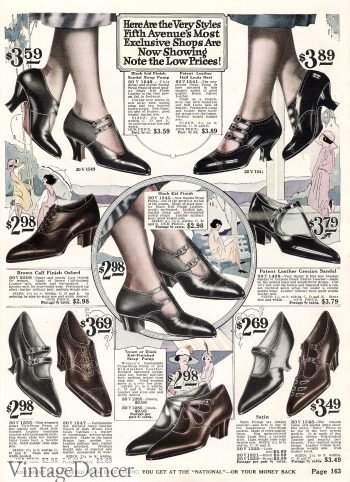
1922 Ladies shoes
1. Mary Janes Shoes
One of the most recognizable shoe styles of the 1920s, Mary Janes were a staple for women of all ages. These low-heeled shoes featured a rounded toe, a strap across the instep, and a button or buckle closure. Mary Janes were often made from patent leather or fabric, and they were available in various colors and patterns. These comfortable and versatile shoes perfectly complemented the flapper dresses and dropped waistlines that defined the era.
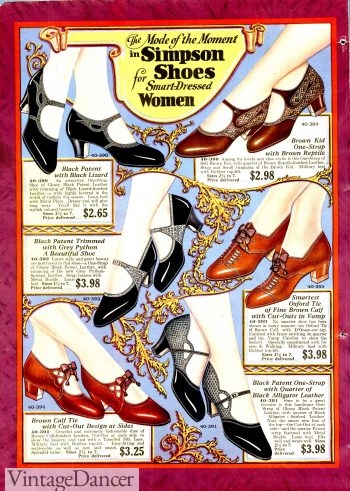
1928 heels, Art Deco influenced designs
2. T-Strap Heels
T-strap heels were the epitome of glamour and sophistication in the 1920s and 1930s. These shoes featured a strap that extended from the toe to the ankle, creating a T-shape. T-strap heels were typically adorned with intricate cutouts, delicate embroidery, or decorative buckles. With their slender heels and elegant design, T-strap heels added a touch of femininity to any outfit, making them a popular choice for evening wear and special occasions.
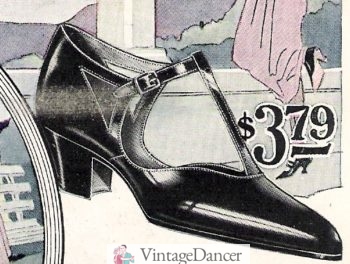
1922 T-Strap heels
The side strap closed at one side with a button or (sometimes) two. Straps with a lot of decoration and two button closures were called “Fasenettas.” Beads and glass paste gems (similar to rhinestones) were all the rage for decorations. Even beaded fringe became necessary to match the elaborate beading on 1920s formal gowns. Other popular options were to make insects and butterflies out of glass beads or colored gauze and place them on the vamp. Heel height was a moderate 2 to 3 inches during the flapper phase.
When just decorating with color became dull, women began to wear colorful hand painted gold, red, and orange pumps. Often, these came with hand painted ‘oriental’ themes which were wildly popular during the Art Deco movement.
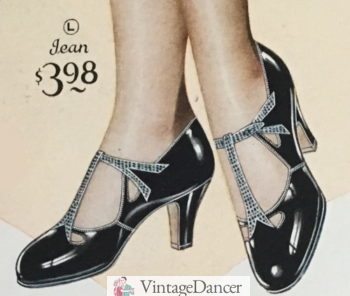
1928 patent T strap evening heels
The flapper movement really embraced bold colors and matching shoes to one’s dresses, stockings, and decoration. If a woman couldn’t dye a pair of shoes to match her dress, she just re-covered them in her same dress material. She could also hand paint her shoes. The T-strap was still the most popular style even for flappers. Despite the fact that some art paintings show women in high heeled open toe sandals, these were NOT worn in the ’20s. They would not have been safe for dancing in, nor were they fashionable even to the liberated flapper girl.
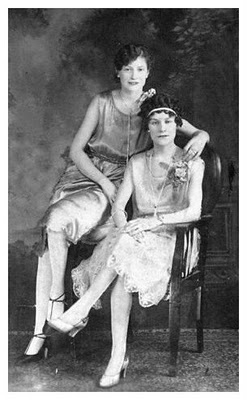
Flappers wearing T-straps and pumps
3. Oxford Shoes
Oxford shoes, originally designed for men, gained popularity among women during the 1920s. These lace-up shoes featured a low heel and a closed toe, providing both comfort and style. Women embraced the androgynous fashion trend of the time, and Oxford shoes became a symbol of women’s empowerment and independence. They were often worn with tailored suits or sporty ensembles, challenging traditional gender norms.
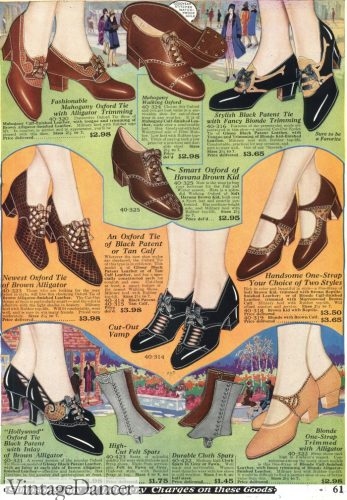
1928 many oxfords shoes (and spats/gaiters too!)
4. Art Deco-inspired Shoes
The Art Deco movement heavily influenced 1920s fashion, and shoes were no exception. Art Deco-inspired shoes featured geometric patterns, bold colors, and intricate embellishments. These shoes were a visual feast, with metallic accents, beading, and embroidery that added a touch of opulence to any outfit. Art Deco-inspired shoes were a statement piece, reflecting the modern and avant-garde spirit of the era.
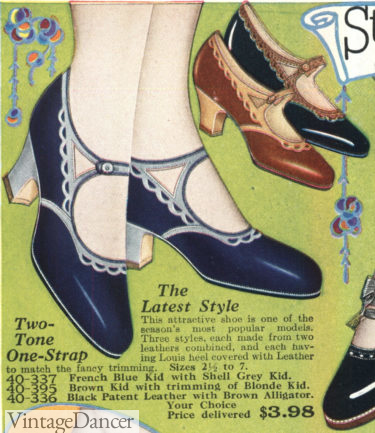
1928 classic Mary Jane shoes
The stock market crash of 1929 caused a crash in flamboyant shoe fashion as well. High heeled T-strap shoes and string tie Oxfords were still popular, but the decorations and the colors became much more minimal. Sleek and simple was in. Flashy was out. Colors were more subtle and muted like evergreen, navy, brown and black for daytime wear. They typically matched or at least didn’t clash with a lady’s outfit.
For evening, matching colors and fabrics were a must. Silk, satin, and velvet were the predominant shoe and dress materials of the ’20s. Accents of silver or gold piping added minimal decoration to plain shoes.
5. Two-Tone Spectator Shoes
Spectator shoes, also known as co-respondent shoes, were a popular choice for both men in the 1920s and for women starting in the 1930s. These shoes featured a distinctive two-tone design, with contrasting colors on the toe and heel. Women embraced the sporty and casual aesthetic of spectator shoes, pairing them with pleated skirts, knitted sweaters, and other casual attire. The contrasting colors added a playful touch to the overall look.
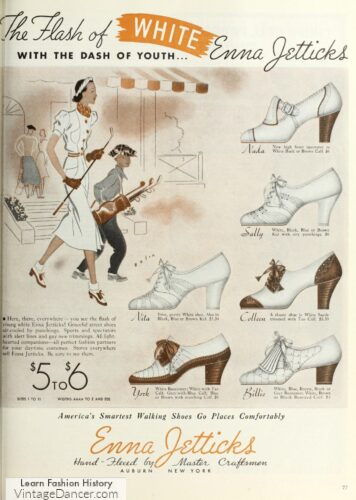
1938 Emma White spectator shoes
The 1920s was a transformative era for women’s fashion, and shoes played a significant role in defining the style of the time. From the iconic Mary Janes to the glamorous T-strap heels, 1920s shoes for women were a perfect blend of comfort, style, and individuality. Today, these vintage shoe styles continue to inspire modern fashion, reminding us of the timeless elegance and boldness of the Roaring Twenties. So, step into the past and embrace the spirit of the 1920s with these iconic shoe styles!
Shop 1920s Style T-strap, Oxford, and Mary Jane Shoes.
Make Your Own 1920s Shoes
Start with a white pair of T-strap leather pumps and apply your favorite bright colored shoe polish. Accent the strap and heel with gold or silver fabric paint (a paint pen works great) or stick on rhinestones. You can also use a paint pen to draw zigzags, wings, or other Art Deco images across the shoe. Presto! You have your own unique pair of 1920s shoes.
These shoes are Astorias from American Duchess, where I just used rhinestone stickers to add some sparkle. Recollections at Michael’s craft stores make a great assortment of stick-on appliques for scrap books that work great as temporary decorations on shoes.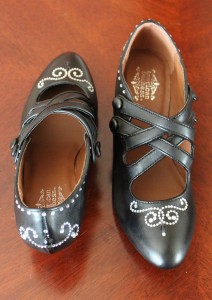
Read more about 1920s women’s shoes.
1930s Women’s Shoes
The one shoe style I usually associate with the 1930s is not the style itself, but the decoration technique. Cut-out, cutaway, and punch-outs are all terms used to describe small perforated decorative holes in the shoe body or accent material. Cutouts could be used on Oxfords, pumps, heels, and any other shoes.
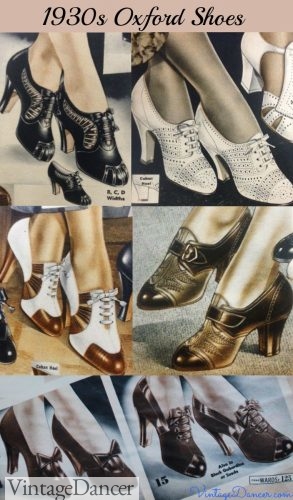
1930s Oxford shoes
Every ’30s women had to have a white and “whatever color was your favorite” two-tone shoe. The two-toned color combination was seen on both casual and evening wear styles. Men, too, embraced the striking patterns of two-toned shoes and together women and men walked into the 1940s with style. Read more about women’s 1930s shoes here.
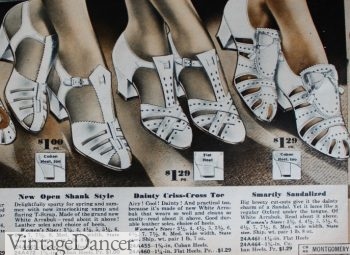
1937 white sandal heels
Although there was great concern for the health of women’s feet during the mid 1930s, the desire for more freedom in footwear was greater. Open toe, peep toe, and sandals with criss-cross slingback heel straps were a welcome daytime choice. The late ’30s also brought about clunky cork wedge heels (also known as “spool heels”) and platform shoes. Read more about these and other 1940s Style Shoes here.
Shop 1930s Style shoes
Also, see 1920’s Women’s Clothes and 1930’s Women’s Clothing for vintage-inspired dresses.
Debbie Sessions has been teaching fashion history and helping people dress for vintage themed events since 2009. She has turned a hobby into VintageDancer.com with hundreds of well researched articles and hand picked links to vintage inspired clothing online. She aims to make dressing accurately (or not) an affordable option for all. Oh, and she dances too.